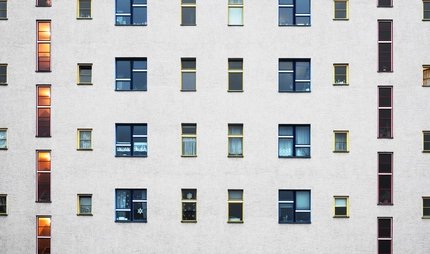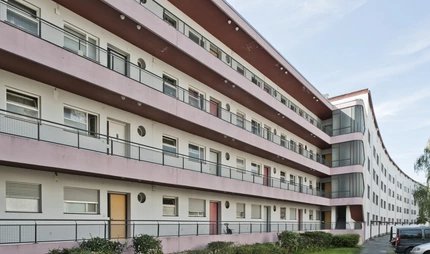
Gropiusstadt – Britz-Buckow-Rudow
The satellite city in the south-east of Berlin
But the way Gropiusstadt was built was much more densely packed than the architect’s plans for a spacious city of the future.
In the 1950s, the destruction of the war meant there was a shortage of housing in West Berlin. Outside the city centre, a new, modern housing project was to be built. The choice fell on vacant farmland south of Neukölln, in the districts of Britz, Buckow and Rudow.
On green fields
Britz-Buckow-Rudow, or BBR for short, was to be a satellite city with schools, shops and leisure facilities.
In 1959/60, the West Berlin Senate recruited Walter Gropius, the renowned architect and founder of the Bauhaus in Weimar, to execute the project. Together with The Architects Collaborative (TAC), the architectural firm that he founded, Gropius set about designing a large-scale housing complex.
Open but structured
The draft urban planning for BBR described a “structured and spacious city”. The buildings were to be arranged in neighbourhoods and crossed by green spaces. Residents would be able to use central infrastructure such as the Walter Gropius School.
An extension of the U7 underground line with the new stations Johannisthaler Chaussee, Lipschitzallee, Wutzkyallee and Zwickauer Damm was also part of the concept.
Walter Gropius’s design was inspired by the proximity to the Britz district and Bruno Taut’s famous Hufeisensiedlung. He wanted to create a circle reminiscent of the horseshoe, consisting of twelve high-rise buildings, directly surrounded by rows of terraces and detached houses. None of the buildings were to be higher than five storeys.
Going too high
When the estate was built between 1962 and 1975, it was very different to the way the architect had planned it.
In 1961, not long after the contract was awarded, the Berlin Wall cut the city in two. Building land on the outskirts of West Berlin was suddenly in short supply. The solution was to build upwards. At BBR, many tower blocks were packed into a small space. With 31 storeys, the Ideal Tower is still the tallest residential building in Berlin.
Walter Gropius didn’t live to see the project completed, having died in 1969. The Britz-Buckow-Rudow estate was officially named Gropiusstadt in 1972.
Problems in social housing
Over the decades Gropiusstadt, which was conceived on paper as the ideal satellite city, developed into a much maligned problem neighbourhood.
This was caused by various factors, such as the high density of housing and the tenant structure, and not least the poor quality of the outdoor spaces. In her book “Wir Kinder vom Bahnhof Zoo” Christiane Felscherinow described the dreariness of the place where she grew up. Gropiusstadt gained a bleak reputation in the 1980s.
A lot has changed since then. Major investment in infrastructure since the turn of the millennium has made the area more attractive to new tenants. Since 2014, new houses have been built on the green spaces, and projects to improve accessibility and develop recreational areas will be completed by 2021.
Our tips for Gropiusstadt
Every first Sunday after New Year, the Ideal high-rise block hosts the Tower Run, where competitors run up the 465 steps to the 29th floor. One of the buildings worth seeing in Gropiusstadt is the Walter Gropius School, which opened in 1968. On Baumläuferweg you’ll come across architecture from another century entirely: the Jungfernmühle, built in 1757, is the oldest preserved windmill in Berlin. It was originally situated in Potsdam but arrived via various detours at its present location in Buckow in 1892. Inside it, the Jungfernmühle restaurant welcomes guests – we recommend making a reservation! There are two interesting religious buildings on Lipschitzallee: the protestant Trinity Church built between 1969 and 1971 with its three towering pointed roofs, and the catholic St. Dominicus Church, built from 1975 to 1977 with a unique conical roof. To see a particularly important Berlin Modernism project, take the U7 to Parchimer Allee, to Bruno Taut’s famous Hufeisensiedlung.
Practical information from visitBerlin
You can get to Gropiusstadt by taking the U7 underground line to Johannisthaler Chaussee, Lipschitzallee, Wutzkyallee or Zwickauer Damm. To explore the city by public transport, we recommend the Berlin WelcomeCard.



